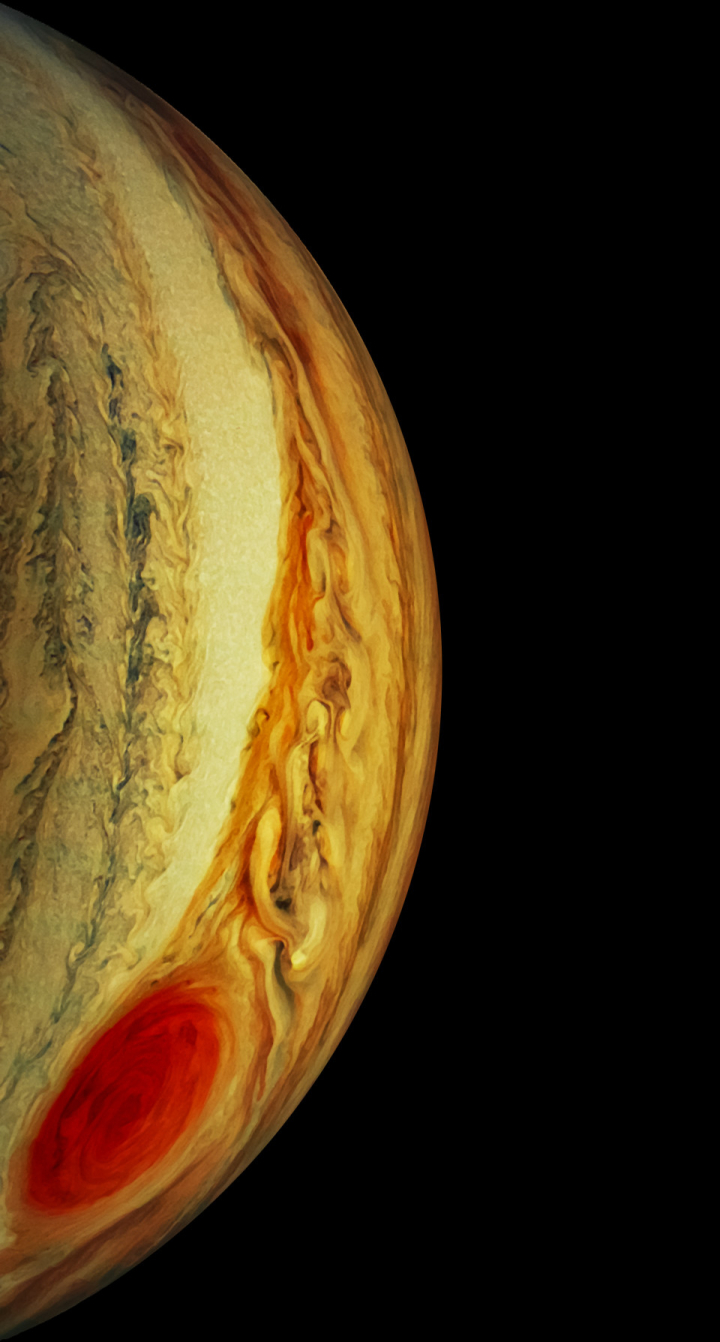The beauty of Jupiter’s Great Red Spot
The cool image below needs little explanation. It shows, in all its beauty, Jupiter’s Great Red Spot, taken from a Juno image during the spacecraft’s 21st fly-by of Jupiter. Citizen scientists Navaneeth Krishnan S enhanced the image only slightly, but that slight work brought out the details quite wonderfully.
On Christmas Eve 1968 three Americans became the first humans to visit another world. What they did to celebrate was unexpected and profound, and will be remembered throughout all human history. Genesis: the Story of Apollo 8, Robert Zimmerman's classic history of humanity's first journey to another world, tells that story, and it is now available as both an ebook and an audiobook, both with a foreword by Valerie Anders and a new introduction by Robert Zimmerman.
The print edition can be purchased at Amazon or from any other book seller. If you want an autographed copy the price is $60 for the hardback and $45 for the paperback, plus $8 shipping for each. Go here for purchasing details. The ebook is available everywhere for $5.99 (before discount) at amazon, or direct from my ebook publisher, ebookit. If you buy it from ebookit you don't support the big tech companies and the author gets a bigger cut much sooner.
The audiobook is also available at all these vendors, and is also free with a 30-day trial membership to Audible.
"Not simply about one mission, [Genesis] is also the history of America's quest for the moon... Zimmerman has done a masterful job of tying disparate events together into a solid account of one of America's greatest human triumphs."--San Antonio Express-News
The cool image below needs little explanation. It shows, in all its beauty, Jupiter’s Great Red Spot, taken from a Juno image during the spacecraft’s 21st fly-by of Jupiter. Citizen scientists Navaneeth Krishnan S enhanced the image only slightly, but that slight work brought out the details quite wonderfully.
On Christmas Eve 1968 three Americans became the first humans to visit another world. What they did to celebrate was unexpected and profound, and will be remembered throughout all human history. Genesis: the Story of Apollo 8, Robert Zimmerman's classic history of humanity's first journey to another world, tells that story, and it is now available as both an ebook and an audiobook, both with a foreword by Valerie Anders and a new introduction by Robert Zimmerman.
The print edition can be purchased at Amazon or from any other book seller. If you want an autographed copy the price is $60 for the hardback and $45 for the paperback, plus $8 shipping for each. Go here for purchasing details. The ebook is available everywhere for $5.99 (before discount) at amazon, or direct from my ebook publisher, ebookit. If you buy it from ebookit you don't support the big tech companies and the author gets a bigger cut much sooner.
The audiobook is also available at all these vendors, and is also free with a 30-day trial membership to Audible.
"Not simply about one mission, [Genesis] is also the history of America's quest for the moon... Zimmerman has done a masterful job of tying disparate events together into a solid account of one of America's greatest human triumphs."--San Antonio Express-News



That would make for a beautiful glycee print.
I print glycee…give me a call
How amazing it would be to see that in person – I mean, if you could be shielded from the radiation.
How lucky we humans are to have such a beautiful solar system.
Aliens that pass through must be jealous.
Scientists conclude unanimously. “- It’s red! like a lipstick.”
I watched Jupiter as a child, through a 4-5 inch refractor. It was my favorite celestial object. (Saturn wrought its rings against me at the time so it was nothing but a blob.) The disc of Jupiter blinds out background stars so that its four moons are clearly distinguishable. Jupiter’s belts are clear, it’s a striped planet. And its red spot. All in much fainter colors that are here enhanced.
What’s great with Jupiter is its fast rotation and its fast moons. During the same night, Jupiter revolves 180+ degrees. One can see the red spot move from hour to hour. And its quick moons change their constellation. The state of Jupiter’s moons (and the red spot?) was in the 18th century suggested as a solution for time keeping before reliable mechanical clocks were engineered. The problem to be solved being the longitude of a ship at sea. But it was of course very impractical to make astronomical observations with a telescope on a ship, the half of the time that Jupiter is in the night sky, disregarding weather. They should’ve gone with the pulsar clock.
Richard M: Same thought; orbiting hotel; but the radiation environment . . . Oh, well. Still pretty to look at through robot eyes.